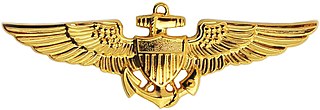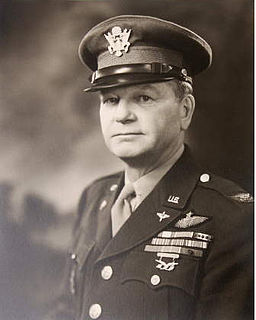
Robert Lee Stewart is a retired brigadier general of the United States Army and a former NASA astronaut.

The United States Astronaut Badge is a badge of the United States, awarded to military pilots, naval flight officers, navigators/combat systems officers, flight surgeons, and civilian pilots who have completed training and performed a successful spaceflight. A variation of the astronaut badge is also issued to civilians who are employed with the National Aeronautics and Space Administration as specialists on spaceflight missions. It is the least awarded qualification badge of the United States military.
An aviator badge is an insignia used in most of the world's militaries to designate those who have received training and qualification in military aviation. Also known as a Pilot's Badge, or Pilot Wings, the Aviator Badge was first conceived to recognize the training that military aviators receive, as well as provide a means to outwardly differentiate between military pilots and the “foot soldiers” of the regular ground forces.
The Observer Badge is a military badge of the United States armed forces dating from the First World War. The badge was issued to co-pilots, navigators, and flight support personnel who had received a variation in the training required for the standard Pilot's Badge. The Observer Badge survived through the Second World War and into the 1950s, at which time the concept of an Observer Badge was phased out in favor of the modern Aircrew Badge and Navigator-Observer Badges. In addition to wings for Naval Aviators and Naval Flight Officers, the United States Navy still maintains an "Observer Badge" which is issued to flight-qualified mission specialists, such as a select number of meteorologists and intelligence officers in both the U.S. Navy and U.S. Marine Corps. The U.S. Air Force awards its USAF Observer Badge, which is identical to the USAF Navigator Badge, to Air Force officers who have qualified as NASA Space Shuttle Mission Specialists, have flown an actual mission aboard the shuttle and/or the International Space Station and who are otherwise not previously aeronautically rated as an Air Force pilot or navigator.

The U.S. military issues instructor badges to specially training military personnel who are charged with teaching military recruits the skills they need to perform as members of the U.S. Armed Forces or teach continuing education courses for noncommissioned officers and officers in the military. With the exception of the U.S. Army and U.S. Coast Guard, these badges are considered temporary military decorations and must be surrendered upon completion of one's duty as a military instructor. Because of this, the U.S. Air Force, U.S. Navy, and U.S. Marine Corps award Drill Instructor Ribbons as a permanent decoration to recognize service members who have qualified and performed as military instructors.
The Navigator Badge is a military qualification badge of the United States Air Force which was first created during the Second World War. The current USAF badge is designated by Air Force Instructions as the Navigator/Observer Badge and is issued to rated officers in both rating categories. In 2009, it was renamed as the Combat Systems Officer badge.

The Women Airforce Service Pilots Badge is an award of the United States Army that was issued during the Second World War. The badge created for the Women Airforce Service Pilots, or WASP, was awarded to more than a thousand women who had qualified for employment as civilian, non-combat pilots of military aircraft used by the U.S. Army Air Forces during World War II. The first wings were privately and hastily designed and paid for out of the pockets of Floyd Odlum and his wife, Jacqueline Cochran, who in 1942 became the head of WASP.
The Balloon Pilot Badge is a military badge of the United States Armed Forces which was issued during the First and Second World Wars. The badge was issued by both the United States Army and the U.S. Air Force, with the Navy equivalent known as the Dirigible Pilot Badge.
A Drill Instructor Ribbon is a military award of the United States Armed Forces which is issued by the U.S. Navy, U.S. Air Force and U.S. Marine Corps. The Drill Instructor Ribbon recognizes those service members who are trained and qualified as military instructors to new recruits during initial basic training.
The Flight Surgeon Badge is a military badge of the United States Armed Forces which has existed since the Second World War.
The Recruiting Service Ribbon is a military award of the United States Armed Forces which is issued by every branch of service with the exception of the United States Army. The Recruiting Service Ribbon recognizes those military service members who have completed a successful tour as a military recruiter in one of the United States Military Recruiting Commands.

Identification badges of the Uniformed Services of the United States are insignia worn by service members conducting special duties, many of which can be awarded as permanent decorations if those duties are performed successfully. There are a few identification badges that are awarded to all services, others are specific to a uniform service. The Office of the President and Vice President and department/service headquarters badges are permanent decorations for those who successfully serve in those assignments. Some of the service level identification badges can be permanent decorations and others are only worn by a service member while performing specific duties, such as the Military Police Badge.

Badges of the United States Army are military decorations issued by the United States Department of the Army to soldiers who achieve a variety of qualifications and accomplishments while serving on active and reserve duty in the United States Army.

Badges of the United States Air Force are specific uniform paraphernalia authorized by the United States Air Force that signify aeronautical ratings, special skills, career field qualifications, and serve as identification devices for personnel occupying certain assignments.
An aircrew brevet is the badge worn on the left breast, above any medal ribbons, by qualified aircrew in the Royal Air Force, British Army, Indian Air Force, Pakistan Air Force, Royal Canadian Air Force, Australian Army, Royal Australian Air Force, Royal New Zealand Air Force, South African Air Force and Sri Lanka Air Force.
The Aircrew Badge, commonly known as Wings, is a qualification badge of the United States military that is awarded by all five branches of armed services to personnel who serve as aircrew members on board military aircraft. The badge is intended to recognize the training and qualifications required by aircrew of military aircraft. In order to qualify as an aircrew member and receive the Aircrew Badge, such personnel typically undergo advanced training in aircraft in-flight support roles.

A Naval Aviator is a commissioned officer or warrant officer qualified as a pilot in the United States Navy, United States Marine Corps or United States Coast Guard.

Thomas DeWitt Milling was a pioneer of military aviation and a brigadier general in the U.S. Army Air Corps. He was the first rated pilot in the history of the United States Air Force.

U.S. Air Force aeronautical ratings are military aviation skill standards established and awarded by the United States Air Force for commissioned officers participating in "regular and frequent flight", either aerially or in space, in performance of their duties. USAF aeronautical badges, commonly referred to as "wings" from their shape and their historical legacy, are awarded by the Air Force in recognition of degrees of achievement and experience. Officers earning these badges and maintaining their requirements are classified as rated officers and receive additional pay and allowances.















